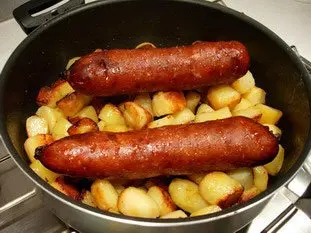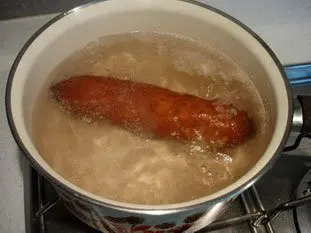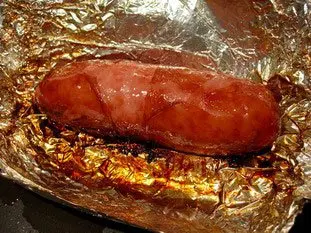This site uses only a few technical cookies necessary for its operation. By continuing to browse, you accept their use.
To find out more...
To find out more...
Should a sausage be pricked before cooking?

If you are using sausages in a recipe, you may have already asked yourself the question: Should you prick it before cooking it, or not?
You will certainly find as many opinions "you should prick" as "you should not".
Let's try to untangle all this.
You will certainly find as many opinions "you should prick" as "you should not".
Let's try to untangle all this.
48 K 4.1/5 (18 reviews)
Keywords for this post:SausageCookingNeedleForkKnifeBrothBriocheLast modified on: September 29th 2018
Should a sausage be pricked before cooking?
A sausage, well a good one, that is to say not an industrial by-product, is a piece of gut in which is threaded a mixture of meat, spices and salt. The casing is closed at both ends, and the sausage thus formed is put to dry or to smoke. Molène sausage for example, Morteau sausage (the best in the world, no less...), or many others.
So obviously if you cook it by poaching it, i.e. in boiling water, pitting it will cause some of the cooking water to enter the sausage and "steal" some of its taste, its smoke. So, okay, it's better not to prick it.
That said, cooking a sausage by poaching is not the best way to cook it, even if it is not pricked, the contact with boiling water is not necessarily interesting for the taste.
You will get a much better result with an oven cooking: Roll the sausage in a sheet of aluminium foil, put it on a plate or a dish and put it in the oven at 180° for about 40/45 minutes (in the case of a Morteau, 30 minutes for a Molène), the sausage will cook of course, but it will also caramelize a bit, and its taste will be sublimated by this long cooking at a reasonable temperature.
And by the way, spiked or not in this case? Well, a little bit as you want, if you prick some of the fat will escape and you will have a sausage a little less fatty, but also a little drier, it's up to you.
If you make a sausage in a bun for example, I strongly advise you to cook it in the oven.
In another case, the sausage is cooked in, or in contact with, its filling: potatoes, beans, lentils,..., then it's quite clear: you MUST prick, this way the taste of the sausage will fall (or go down) on the filling, the potatoes for example, and you will have an exceptional dish in taste!
I come back to the poached sausage, which is not pricked, in principle. I say "in principle" because in fact you can poach it if you want to do a double job, that is to say cook the sausage, but also obtain a very fragrant cooking broth from the water.
In this case, you will notice that the cooking water becomes cloudy and a little fatty as it cooks, because of the exchange that takes place with the sausage. At the end of the cooking process, remove the sausage, and you will have in the pan not only water but a "Molène broth" or "Morteau broth" that you can happily use to cook rice for example, vegetables, pasta, or a little bit of everything you want, and this cooking with broth will be much more tasty than a "l'anglaise" cooking (boiling salted water).
To sum up: Should a sausage be pricked before cooking? Well, it depends on the cooking method, and can we draw a general rule from this? Let's try it...
So obviously if you cook it by poaching it, i.e. in boiling water, pitting it will cause some of the cooking water to enter the sausage and "steal" some of its taste, its smoke. So, okay, it's better not to prick it.

That said, cooking a sausage by poaching is not the best way to cook it, even if it is not pricked, the contact with boiling water is not necessarily interesting for the taste.
You will get a much better result with an oven cooking: Roll the sausage in a sheet of aluminium foil, put it on a plate or a dish and put it in the oven at 180° for about 40/45 minutes (in the case of a Morteau, 30 minutes for a Molène), the sausage will cook of course, but it will also caramelize a bit, and its taste will be sublimated by this long cooking at a reasonable temperature.
And by the way, spiked or not in this case? Well, a little bit as you want, if you prick some of the fat will escape and you will have a sausage a little less fatty, but also a little drier, it's up to you.
If you make a sausage in a bun for example, I strongly advise you to cook it in the oven.

In another case, the sausage is cooked in, or in contact with, its filling: potatoes, beans, lentils,..., then it's quite clear: you MUST prick, this way the taste of the sausage will fall (or go down) on the filling, the potatoes for example, and you will have an exceptional dish in taste!

I come back to the poached sausage, which is not pricked, in principle. I say "in principle" because in fact you can poach it if you want to do a double job, that is to say cook the sausage, but also obtain a very fragrant cooking broth from the water.
In this case, you will notice that the cooking water becomes cloudy and a little fatty as it cooks, because of the exchange that takes place with the sausage. At the end of the cooking process, remove the sausage, and you will have in the pan not only water but a "Molène broth" or "Morteau broth" that you can happily use to cook rice for example, vegetables, pasta, or a little bit of everything you want, and this cooking with broth will be much more tasty than a "l'anglaise" cooking (boiling salted water).
To sum up: Should a sausage be pricked before cooking? Well, it depends on the cooking method, and can we draw a general rule from this? Let's try it...
- Poached => do not poach, unless you want to obtain a broth at the same time
- Oven cooking => do not poach if you want to reduce the fat, but be careful => sausage is drier, otherwise do not poach
- Cooked in contact with the filling => we prick!
Lasts posts
Butter vs. grease
We often read in a recipe where a pastry is put into a mould that, just before pouring, the mould should be buttered or greased. But what's the difference between these 2 terms?December 1st 20251,6075
Getting out of the fridge early
Very often when you're cooking, you need to take food or preparations out of the fridge, to use them in the recipe in progress. There's nothing tricky about this: you just take them out of the fridge and use them, usually immediately, in the recipe. But is this really a good method?November 24th 20251,3045
Who's making the croissants?
When you look at a bakery from the outside, you naturally think that in the bakery, the bakers make the bread, and in the laboratory, the pastry chefs make the cakes. It's very often like that, with each of these professions having quite different ways of working, but sometimes there's also one...November 23th 20251,200
Oven height
When we put a dish or cake in the oven, we naturally tend to put it on the middle shelf, and that's what we usually do. But in some cases, this position and height can be a little tricky, so let's find out why.October 8th 20253,4715
The importance of sieving
In recipes that use a fine powder (flour, powdered sugar, etc.), you'll often see the advice to sift before using it. To sift is to pass the powder in question through a sieve (a very fine strainer) before incorporating it into your recipe. It's often advice, but is it really useful?September 3rd 20258,0303
Other pages you may also like
Artichoke stalks
When preparing artichokes for cooking, you may well already know that we often need to remove the first round of leaves, if they are tatty or dirty, as well as the inedible stalk. The operative word here is “remove” , rather than “cut off”.October 25th 201654 K4.3
Perpetual stock
It's something you have probably have done yourself: cooked or pre-cooked vegetables before adding them to a recipe. This is almost always done the same way: peel the chosen vegetables (carrots, for example), cut them up, boil them in salted water (using a tablespoon or so of coarse salt per litre),...November 22th 201631 K5
Stand mixer tools
Whether we call it a stand mixer, food processor, or simply refer to it by brand (Kenwood, KitchenAid, etc.), this machine is a valuable tool for amateur cooks, bakers or pastry chefs like ourselves. All these machines come supplied with 3 different tools. Let’s take a look at their names and...November 2nd 201938 K4.5
Should I believe my oven?
Can you really trust your oven? This is an important question as we are always tempted to take the temperature indicated as gospel truth and, unfortunately, this is rarely very precise. .July 4th 201133 K4.6
Raising (or leavening) agents
When we want to make a dough or batter rise when baking, either in patisserie or bread-making, we need to use a raising agent or leavening agent, one of which is called leaven. In the context of baking, a raising agent is simply what "makes something rise". It is a substance which, when added to...June 16th 202157 K4.8
Post a comment or question
Follow this page
If you are interested in this page, you can "follow" it, by entering your email address here. You will then receive a notification immediately each time the page is modified or a new comment is added. Please note that you will need to confirm this following.
Note: We'll never share your e-mail address with anyone else.
Alternatively: you can subscribe to the mailing list of cooling-ez.com , you will receive a e-mail for each new recipe published on the site.









